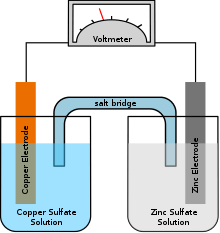Half-cell
In electrochemistry, a half-cell is a structure that contains a conductive electrode and a surrounding conductive electrolyte separated by a naturally occurring Helmholtz double layer. Chemical reactions within this layer momentarily pump electric charges between the electrode and the electrolyte, resulting in a potential difference between the electrode and the electrolyte. The typical anode reaction involves a metal atom in the electrode dissolved and transported as a positive ion across the double layer, causing the electrolyte to acquire a net positive charge while the electrode acquires a net negative charge. The growing potential difference creates an intense electric field within the double layer, and the potential rises in value until the field halts the net charge-pumping reactions. This self-limiting action occurs almost instantly in an isolated half-cell; in applications two dissimilar half-cells are appropriately connected to constitute a Galvanic cell.
A standard half-cell consists of a metal electrode in a 1 molar (1 mol/L) aqueous solution of the metal's salt, at 298 kelvins (25 °C).[1] The electrochemical series, which consists of standard electrode potentials and is closely related to the reactivity series, was generated by measuring the difference in potential between the metal half-cell in a circuit with a standard hydrogen half-cell, connected by a salt bridge.
The standard hydrogen half-cell:
- 2H+(aq) + 2e− → H2(g)
The half-cells of a Daniell cell:
References
- Andrews, Donald H.; Richard J. Kokes (1962). "Electrochemistry". Fundamental Chemistry. New York: John Wiley & Sons, Inc. p. 482.
